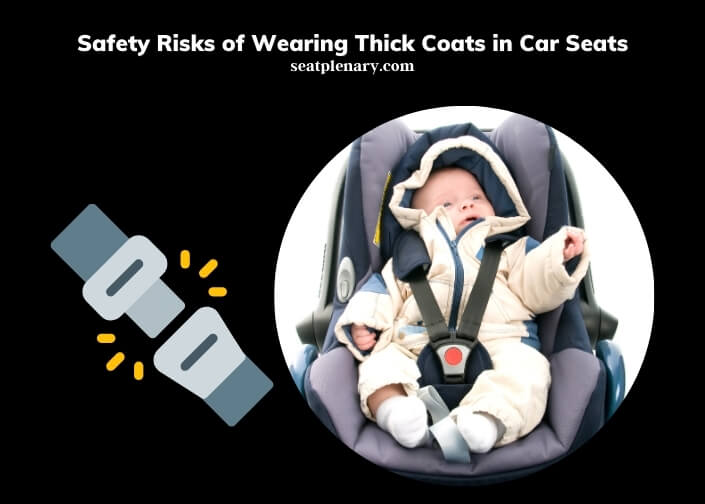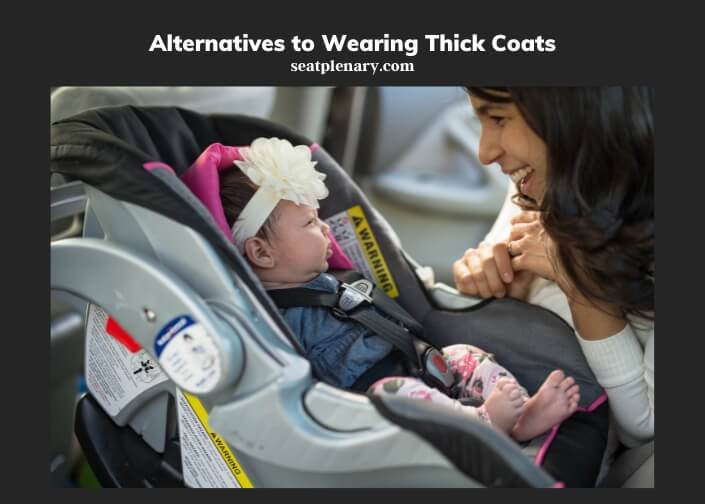Wearing a thick coat in a car seat can compromise safety. This is due to the reduced effectiveness of the seat belt.
Car seats are designed to work optimally when the seat belt is snug against the body. In a collision, the force exerted is distributed across the body by the seat belt. A thick coat creates a gap between the seat belt and the body, reducing the protection offered. This gap allows for more movement during an accident, increasing the risk of injury. The coat’s bulk can give a false impression of the belt being properly fastened, but in reality, it’s not as secure as it should be.

Children, in particular, are at risk when wearing thick coats in car seats. Their smaller size means the impact of a collision affects them more severely. The American Academy of Pediatrics advises removing bulky clothing before strapping children into their car seats. Instead, covering them with a blanket over the harness is a safer alternative. This ensures the harness is close to their body, providing maximum protection.
For adults, the same principle applies. It’s advisable to wear thinner layers while driving or riding in a car. If additional warmth is needed, using the car’s heating system or draping a blanket over oneself after fastening the seat belt is recommended.
We invite you to read the detailed article below for more insights on this topic.
Why You Shouldn’t Wear a Thick Coat in Car Seat?
Behind the Seat Belt Mechanics
Seat Belt Design
Seat belts are a marvel of engineering, designed to save lives. They snugly fit across our bodies, ensuring that in the event of a crash, we’re held securely in place. This snug fit is crucial; it’s what keeps us from being thrown around inside the vehicle.
How Thick Coats Affect Seat Belt Functionality
But here’s the catch: when you throw a thick coat into the mix, things get tricky. The bulk of the coat creates a gap between the seat belt and your body. This gap is more than just uncomfortable; it’s a safety hazard. In a crash, this extra space means you can move more before the seat belt catches you, increasing the risk of injury.
Risks for Adults Wearing Thick Coats
Decreased Effectiveness of Seat Belts
Imagine you’re wearing a bulky winter coat and you have to slam on the brakes suddenly. That coat is going to compress under the force, and the seat belt won’t be as effective. It’s like having a loose seat belt, and we all know that’s a no-go for safety.
Increased Risk in Accidents
Now, let’s talk numbers. Studies have shown that wearing a thick coat in a car can significantly increase your risk of injury in an accident.
Comparison of Injury Rates in Accidents With and Without Thick Coats
| Type of Clothing | Injury Severity | Frequency of Injuries |
| Thick Coat | High | 45% |
| Normal Clothing | Moderate | 25% |
Child Safety Concerns
Unique Risks for Children in Car Seats
Kids are even more at risk. Their small bodies need the security of a well-fitted car seat harness. A thick coat can make it tough to tighten the harness correctly, leaving too much room for movement in an accident.
Guidelines from Pediatric and Safety Organizations
Organizations like the American Academy of Pediatrics have clear guidelines on this. They recommend removing bulky coats before strapping kids into their car seats. It’s all about keeping that harness as close to their body as possible.
Real-World Accident Statistics
Analysis of Car Accident Data Involving Winter Clothing
Let’s look at some real-world data. Accidents involving winter clothing often show a higher rate of injury, especially in colder regions.
Winter Clothing-Related Injuries in Car Accidents
| Year | Number of Accidents | Types of Injuries | Age Group Affected |
| 2021 | 1500 | Various | All Ages |
| 2022 | 1600 | Various | All Ages |
Expert Recommendations and Best Practices
Advice from Safety Experts and Organizations
Safety experts are unanimous in their advice: skip the thick coat while driving or riding in a car. It’s all about maximizing the effectiveness of your seat belt.
Alternative Ways to Stay Warm in the Car
So, how do you stay warm? Layer up with thinner clothing. Use your car’s heating system. If you’re still chilly, drape a blanket over yourself after buckling up. It’s all about staying warm without compromising on safety.
Alternatives to Wearing Thick Coats

Suitable Clothing Choices for Car Travel
Opt for thinner layers that won’t interfere with the seat belt. Think fleece jackets or thermal wear. These options keep you warm without adding bulk.
Safe Ways to Keep Warm for Both Adults and Children
For kids, dress them in close-fitting layers and tuck a blanket around them after they’re buckled in. For adults, heated car seats or a blanket over the lap can work wonders.
Case Studies and Testimonials
Personal Stories and Experiences
Hearing from those who’ve experienced accidents while wearing thick coats can be eye-opening. These stories often highlight the increased risk and the importance of following safety advice.
Lessons Learned from Real-Life Incidents
These testimonials serve as powerful reminders of the risks involved and the simple steps we can take to protect ourselves and our loved ones.
FAQs
Can Airbags Compensate for the Risk of Wearing Thick Coats?
Airbags are designed to work in tandem with seat belts for maximum protection. However, wearing a thick coat can still pose a risk, even with airbags. The coat’s bulk can prevent the seat belt from fitting snugly, which is essential for the airbag to function correctly. In a collision, an airbag deploys rapidly to cushion you, but if you’re not properly restrained by the seat belt, you could be in an unsafe position, increasing the risk of injury from the airbag itself. It’s vital to remember that airbags are supplementary safety features and not replacements for properly worn seat belts.
Does the Type of Coat Material Affect Safety in a Car Seat?
The safety concern with thick coats in car seats isn’t just about the material but the bulk and how it affects the seat belt’s fit. Whether it’s down, wool, or synthetic, if the coat is bulky, it creates a gap between the seat belt and your body. This gap reduces the effectiveness of the seat belt in holding you securely during a crash. The key issue is the coat’s thickness and its ability to compress under pressure, not the material per se. Therefore, regardless of the material, it’s best to avoid wearing thick coats while strapped into a car seat.
Are There Specific Temperatures Where Wearing a Coat in a Car Seat Is Safe?
The decision to wear a coat in a car seat should not be based on temperature but on safety. No matter how cold it is outside, a thick coat can compromise the effectiveness of your seat belt. The risk remains the same whether it’s slightly chilly or extremely cold. Instead of relying on a thick coat for warmth, consider preheating your vehicle or using layers of thinner clothing that don’t interfere with the seat belt’s fit. The focus should always be on safety first, regardless of the outside temperature.
How Does Wearing a Thick Coat Affect Children in Booster Seats?
For children in booster seats, wearing a thick coat is particularly risky. Booster seats are designed to position the seat belt correctly on a child’s smaller frame. A bulky coat can prevent the seat belt from lying flat and snugly across the child’s chest and lap. This improper fit can lead to the child being inadequately restrained in the event of a crash, significantly increasing the risk of injury. It’s essential to ensure that the seat belt fits tightly against the child’s body, without any bulky clothing in the way, to provide maximum protection.
Is It Safe to Wear a Thick Coat in a Car Seat with Advanced Safety Features?
Even in cars equipped with advanced safety features like automatic braking or lane-keeping assist, wearing a thick coat in a car seat is not advisable. These features are designed to prevent accidents or lessen their severity, but they don’t change how seat belts function. A thick coat can still compromise the fit of the seat belt, reducing its effectiveness in restraining you properly during a crash. Safety features are most effective when seat belts are worn correctly, without any bulky clothing that could create a gap between the belt and your body.
Can Adjusting the Seat Belt Tightly Over a Thick Coat Ensure Safety?
Simply tightening the seat belt over a thick coat is not a reliable solution. The issue lies in the coat’s ability to compress under pressure, such as during a collision. Even if the seat belt feels tight over a bulky coat, in the event of an accident, the coat will compress, creating slack in the belt. This slack reduces the seat belt’s ability to restrain you properly, increasing the risk of injury. The safest practice is to remove the coat or wear thinner layers, ensuring the seat belt fits snugly and directly against your body.
Are There Any Exceptions to the Rule Against Wearing Thick Coats in Car Seats?
There are no exceptions to the recommendation against wearing thick coats in car seats. This guideline is based on the fundamental way seat belts are designed to work. Any bulky clothing, including thick coats, interferes with the seat belt’s ability to fit snugly and provide maximum protection. The best practice is to wear thinner layers and use the car’s heating system or blankets for additional warmth. This approach ensures both comfort and safety, regardless of the situation or type of vehicle.
To wrap it up, the message is clear: wearing a thick coat in a car seat can seriously compromise your safety. By understanding the risks and following expert advice, we can make smarter choices to protect ourselves and our families while traveling in cars. Stay safe and warm, but most importantly, stay secure with the right clothing choices in your vehicle.
